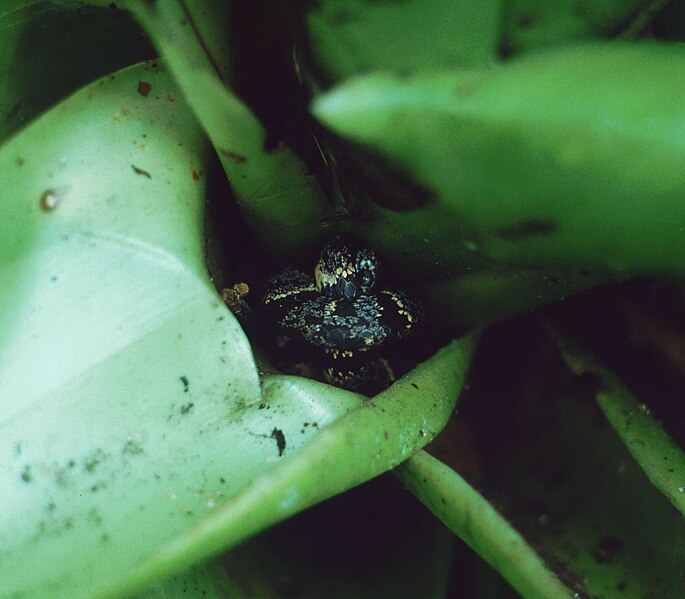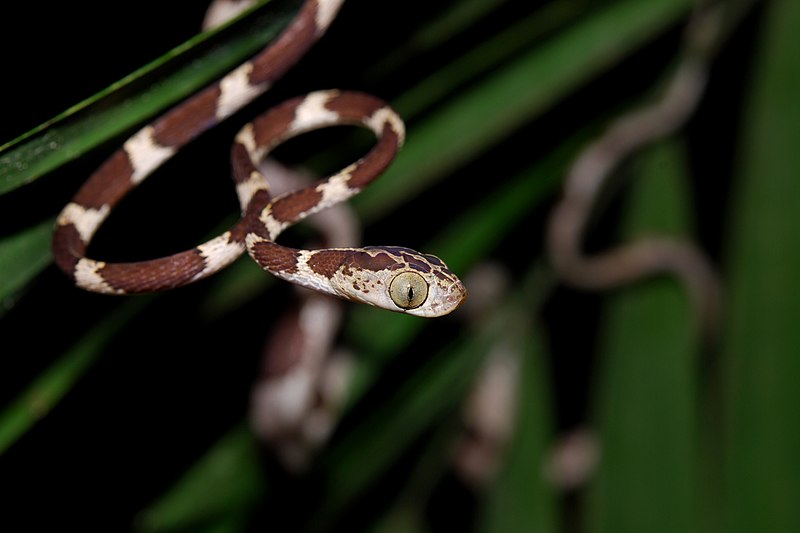 An amazing array of newly-discovered reptiles and amphibians grabbed our attention this past year. The unexpected discoveries of an undescribed Leopard Frog in New York City and a Rainbow Skink in an Australian backyard reminded us that wonderful surprises surround us, if only we take the time to look and learn. Frogs that dye human skin yellow, snakes that specialize in eating only eggs or snails, iridescent skinks sporting tails twice their body length…the list is simply astounding. Today I’ll highlight a few that have especially captivated me; please post your own favorites (whether covered here or not) below.
An amazing array of newly-discovered reptiles and amphibians grabbed our attention this past year. The unexpected discoveries of an undescribed Leopard Frog in New York City and a Rainbow Skink in an Australian backyard reminded us that wonderful surprises surround us, if only we take the time to look and learn. Frogs that dye human skin yellow, snakes that specialize in eating only eggs or snails, iridescent skinks sporting tails twice their body length…the list is simply astounding. Today I’ll highlight a few that have especially captivated me; please post your own favorites (whether covered here or not) below.
Australian Rainbow Skinks
2012 was designated as the Year of the Lizard by several conservation organizations, so I’ll lead off with 3 new skinks that turned up in Queensland, Australia. The brilliant colors of breeding males lend these tropical lizards their common names (please see article below).
The Elegant Rainbow Skink, Carlia decorata, was well known to folks in Townsville, Queensland, as a common garden resident. Upon taking a closer look, however, herpetologists realized that the colorful creature was an undescribed species.
The Orange-Flanked Rainbow Skink, C. rubigo, was first collected in the arid scrub and open woodlands of eastern-central Queensland.
The Whitsunday Rainbow Skink, C. inconnera, is limited in range to 4 small offshore islands. Formerly considered to be a subspecies of a mainland relative, genetic studies have revealed that it warrants full species status.
“No to the Mine” Snail-Eating Snake, Sibon noalamina
Western Panama’s Tabasara Mountain Range yielded this year’s most “politically-active” species. Its species’ name means “No to the mine”, and was given in support of the indigenous Ngobe People’s battle against the development of their montane rainforest home.
I’ve always been fascinated by snakes that specialize in hunting snails and other unusual (for snakes) prey. This video of a related Sibon species consuming a snail illustrates its unique feeding strategy. Panama’s newly-described Snail-Eating Snake is a Coral Snake mimic, and its bold coloration changes with maturity; I’m wondering if it mimics more than one species over its lifetime?
New York City Leopard Frog
This year’s “most unlikely” new species must surely be the Leopard Frog that was discovered in NYC (shattering, incidentally, my belief that I have observed and kept all herps native to my hometown!).
Uncovered by a sharp-eared Rutgers University student who noted an unfamiliar call one evening on Staten Island, the frog was at first thought to be a hybrid of the Northern Leopard Frog and the Southern (which may be extinct in NY). But it is indeed distinct – and its range, centered (in years past) in the Yankee Stadium area, falls entirely within NYC and its suburbs. I’ve written more about this urban frog here.
Cambodian Kukri, Oligodon kampucheaensis
Oddly-shaped fangs that resemble the distinctive Nepalese kukri dagger lend this unique group of snakes their common name. The unusual teeth are used to slice open bird and reptile eggs as they are being swallowed.
The newly-described species is quite beautiful, being rusty-red in color and bearing black-bordered white rings (please see article).
Yellow Dyer Rain Frog, Diasporus citrinobapheus
This tiny (0.8 inch), brightly-colored frog delivered a big surprise – the first person to collect one came away with yellow-dyed hands! So far, chemical tests of the dye have revealed no toxins, but frog secretions are very complex, so I’m keeping an eye out for further information.
In common with related species, the Yellow Dyer Rain Frog has no tadpole stage, and is native to montane rainforests in western Panama.
Iridescent Cambodian Skink, Lygosoma veunsaiensis
The skin of this newfound skink flashes a rainbow of colors when illuminated by sunlight. But one must look long and hard to see this creature in the sun (or at all!), as it is highly-adapted to life below ground. Lygosoma’s legs are unusually short, and the tail is twice the length of the body (please see photo). Herpetologists consider its discovery to be a stroke of good luck…related species are so secretive that that most are known from but a few specimens.
The skink is a rainforest dweller, and was found in the Veun Sai-Siem Pang Conservation Area, home also to a newly-described gibbon and bat.
Chocoan Blunt-Headed Vine Snake, Imantodes chocoensis
 As can be seen from the accompanying photo, snakes in the genus Imantodes have huge eyes bulging from heads that seem too large for their pencil-thin necks. But their odd structure suits them well as arboreal, nocturnal hunters of frogs and lizards. Armed with excellent vision, they move by literally flinging themselves through the bushes, and can lash out at prey with blinding speed while anchored to a branch.
As can be seen from the accompanying photo, snakes in the genus Imantodes have huge eyes bulging from heads that seem too large for their pencil-thin necks. But their odd structure suits them well as arboreal, nocturnal hunters of frogs and lizards. Armed with excellent vision, they move by literally flinging themselves through the bushes, and can lash out at prey with blinding speed while anchored to a branch.
The group’s newest member was discovered in northeastern Ecuador. In common with related species, it is rear-fanged and clad in cream, copper, brown, and black. Herpetologists are puzzled at its lack of a loreal scale, which is present in all other Colubrid snakes.
Other Recently-Discovered Amphibians and Reptiles
A number of other fascinating creatures made herp headlines in the recent past. Among the most surprising have been arboreal tadpoles that eat bark, a fanged frog that ambushes birds, large, colorful monitors, and a new Map Turtle from the USA.
Further Reading
New Leopard Frog Discovered in NYC
Sibon nebulatus image referenced from wikipedia and originally posted by Franz Xaver
Blunt Head Vine Snake image referenced from wikipedia and originally posted by Geoff Gallice
 That Reptile Blog – Reptile, Amphibian and Exotic Pet Care and Information
That Reptile Blog – Reptile, Amphibian and Exotic Pet Care and Information



I like the chocoan vine snake.
Thanks, Colin…they really are very unusual, and interesting. I’ve kept other types at the zoo,. but none related to this species. Maybe someday…
Best, Frank
All of them are so amazing!!!
I’ll choose all.
Well said,, feel the same!